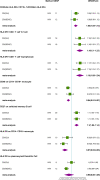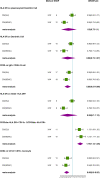The immune factors have complex causal regulation effects on inflammatory bowel disease
- PMID: 38264669
- PMCID: PMC10803565
- DOI: 10.3389/fimmu.2023.1322673
The immune factors have complex causal regulation effects on inflammatory bowel disease
Erratum in
-
Corrigendum: The immune factors have complex causal regulation effects on inflammatory bowel disease.Front Immunol. 2024 Jan 23;15:1368428. doi: 10.3389/fimmu.2024.1368428. eCollection 2024. Front Immunol. 2024. PMID: 38322256 Free PMC article.
Abstract
Background: Although a correlation between immune cell phenotypes and inflammatory bowel disease (IBD) has been established, a causal relationship remains unestablished.
Methods: To assess causal associations between immune cell phenotypes and IBD and its subtypes, we employed Mendelian randomization (MR) methods and genome-wide association studies (GWAS) summary statistics. The primary outcomes were determined based on the inverse variance weighting (IVW) results, with the assessment of heterogeneity and pleiotropy conducted through Cochrane's Q-test and MR-Egger. The stability of the MR results was then examined using leave-one-out analysis, and false discovery rate (FDR) correction was applied to evaluate the strength of the causal relationship between exposure and outcome. Furthermore, to identify immunophenotypes strongly associated with IBD, a meta-integration of the effect values of all positive results in both datasets was conducted.
Results: The analysis of 731 immune cell phenotypes and IBD using MR techniques revealed potential causal associations between 26 phenotypes and IBD. Subsequent meta-integration of the two datasets provided evidence of solid causal associations between 18 immune phenotypes and IBD and its subtypes. Nominal causal associations were also identified in the remaining eight immune phenotypes and IBD and its subtypes.
Conclusion: Our study confirms causal solid associations between 18 immune phenotypes and IBD, thus guiding future clinical studies.
Keywords: Crohn’s disease; Mendelian randomization; causal relationship; inflammatory bowel disease; ulcerative colitis.
Copyright © 2024 Qiu, Zhang, Qin, Ma and Wang.
Conflict of interest statement
The authors declare that the research was conducted in the absence of any commercial or financial relationships that could be construed as a potential conflict of interest.
Figures




Similar articles
-
Are neurodegenerative diseases associated with an increased risk of inflammatory bowel disease? A two-sample Mendelian randomization study.Front Immunol. 2022 Sep 8;13:956005. doi: 10.3389/fimmu.2022.956005. eCollection 2022. Front Immunol. 2022. PMID: 36159838 Free PMC article.
-
Relationship between inflammatory bowel disease and erectile dysfunction: a 2-sample Mendelian randomization study.Sex Med. 2024 Jan 23;11(6):qfad067. doi: 10.1093/sexmed/qfad067. eCollection 2023 Dec. Sex Med. 2024. PMID: 38264202 Free PMC article.
-
Causal linkage between type 2 diabetes mellitus and inflammatory bowel disease: an integrated Mendelian randomization study and bioinformatics analysis.Front Endocrinol (Lausanne). 2024 Jan 19;15:1275699. doi: 10.3389/fendo.2024.1275699. eCollection 2024. Front Endocrinol (Lausanne). 2024. PMID: 38313367 Free PMC article.
-
Causal association between inflammatory bowel disease and herpes virus infections: a two-sample bidirectional Mendelian randomization study.Front Immunol. 2023 Jul 3;14:1203707. doi: 10.3389/fimmu.2023.1203707. eCollection 2023. Front Immunol. 2023. PMID: 37465669 Free PMC article.
-
Association between inflammatory bowel disease and frailty: a two-sample Mendelian randomization study.Aging Clin Exp Res. 2024 Feb 6;36(1):21. doi: 10.1007/s40520-023-02688-1. Aging Clin Exp Res. 2024. PMID: 38319411 Free PMC article.
Cited by
-
Ulcerative Colitis, LAIR1 and TOX2 Expression, and Colorectal Cancer Deep Learning Image Classification Using Convolutional Neural Networks.Cancers (Basel). 2024 Dec 19;16(24):4230. doi: 10.3390/cancers16244230. Cancers (Basel). 2024. PMID: 39766129 Free PMC article.
-
Investigating the dual causative pathways linking immune cells and venous thromboembolism via Mendelian randomization analysis.Thromb J. 2025 Jan 23;23(1):8. doi: 10.1186/s12959-025-00692-1. Thromb J. 2025. PMID: 39849535 Free PMC article.
References
MeSH terms
Substances
LinkOut - more resources
Full Text Sources

